The Belfast Blitz
The Fire Raid
It was clear to the Germans that the attack on Easter Tuesday had failed in its primary aims. German reports referred to the raids impact as 'minimal' and 'unsatisfactory'. Despite the devastating loss of life, only minor damage had been inflicted on the war industries in the city by the Luftwaffe. In the weeks after the raid, the Luftwaffe continued its assault on London and port towns. Aware that Belfast was still under the threat of another attack, the Northern Ireland government attempted to improve the defences and increase preparedness of the civilian population. The number of anti-aircraft guns increased to 28, but this was still nowhere near what was needed for a city the size of Belfast. A battery of searchlights was operational (4 troops with 3 searchlights each), and the balloon barrage strengthened. The civil defence authority increased the number of air raid wardens by 1,200 and new equipment was secured for the ARP and Auxiliary Fire Service. However, before this equipment could arrive the German bombers had returned.
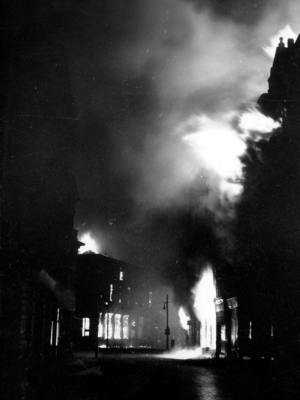
The night of 4-5 May was clear, and the half-moon bathed the city in light. The illumination ensured German pathfinders and bombardiers had no problems identifying their targets. Though the weather was good over the city, low clouds and mist elsewhere meant around 25% of the raiders were redirected to their secondary targets. Over 200 aircraft were en-route from their bases in France and the Netherlands. Just after 12:10am, the sirens wailed over the city, but it was 50 minutes before the first German aircraft were overhead. As before, generators belched smoke to obscure the harbour estate, and the crack of anti-aircraft guns was heard around the city.
The aircraft mostly attacked at heights varying from 9,000 to 13,000 feet, but unlike the previous raid, the attackers found their targets, achieving a relatively high degree of accuracy. German pilots reported they could circle to pick out their targets before dropping their bombloads. As before, high-explosive bombs and parachute mines fell (approximately 237 tons), but many more incendiaries were used, approximately 96,000.
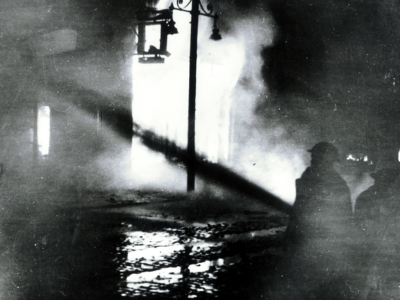
Key targets were the same for the Easter Tuesday raid: the shipyard, aircraft factory, gasworks, oil installations, grain mills, and power station. The Germans prime concern was economic and industrial facilities. With little difficulty in finding their targets, the German attack was devastating.
Bombs and incendiaries in the harbour estate started fires that guided the following aircraft. Large areas of the harbour estate were set ablaze as fires joined to form roaring conflagrations. The Harland and Wolff shipyard was pounded with high explosives and incendiaries, resulting in massive destruction. Workshops, offices, the drawing office, repair shops, stores and manufacturing shops were damaged and destroyed. Vessels under construction and repair were hit. During the raid, 3 near-completed corvettes were destroyed on their slipways, while 3 ships loaded with goods were sunk and 5 more damaged. No other shipyards in the UK suffered as much destruction in a single raid.
Short & Harland aircraft factory was also hit, but less seriously than the shipyards. However, the destruction of the aircraft shop, stores, and records/drawings in the production office caused a halt to Stirling bomber production. Other industrial sites, such as the Belfast Ropeworks, were seriously damaged, which provided much of the cordage to the Royal Navy. It went up in flames and still blazed 24 hours later.
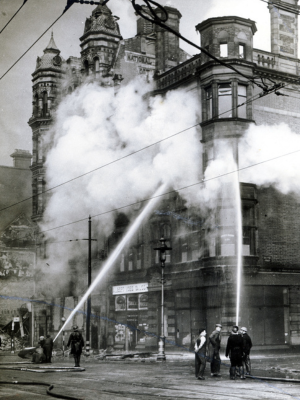
Fires devastated large tracts of industrial area with German pilots reporting the glow was visible 200km away. German after-raid reports claimed a much more significant effect than the Easter Tuesday raid. Much of the commercial centre of Belfast was set ablaze, with the ARP reporting that there were so many incendiaries that they could do little to control the fires. Fires joined into conflagrations as water pressure to fight fires fell away due to broken water mains. Many streets were reduced to smoking ruins: Rosemary Street, Waring Street, Bridge Street, High Street, and North Street.
While Germans had struck their primary targets, the inherent inaccuracy of aerial bombing meant many bombs also fell on residential areas in the east of the city, including much of the Newtownards Road. The area around Ballymacarrett was described as 'a sea of flames'. At the raid's peak, 200 fires raged in Belfast, fifty per cent more than the Easter Tuesday raid, with two conflagrations, 22 major fires, and 58 serious fires reported. The devastation led to this attack being termed 'The Fire Raid'.
W&M226 Interviewee Ernest Stally shared his memories of the Fire Raid:
"Mum had told us not to be frightened of the noise because the noise can't hurt us, but the house, I know the house is frightened of the noise because every time there's a loud bang, it gives a little shiver. This is going on and on and all of a sudden there is a very loud bang and the house seems to jump up in the air. Out in the street, it is like daylight, everywhere you look there's something burning. I'd like to say that ours was the only house, it wasn't actually on fire, but I can't say that, but just up the road from us the house is - one of the houses is alight and it's got flames coming out of every door, window, through the roof. The street, it's full of people running about and it was just like you've gone into a wood and found an ants' nest and given it a kick - they're just running everywhere. They're running in and out of the houses saving their belongings. They're running around, calling out names trying to locate people they've lost during the air raid. And there are others who are just running about, they want to run away, but they don't know where to run to, because there is nowhere to run to, everywhere you look is on fire'.
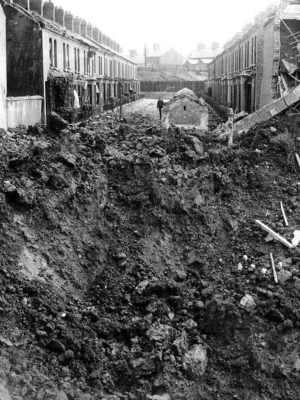
The response from the city’s anti-aircraft batteries was much more sustained than the Easter Tuesday raid, but the barrage could be hazardous for those on the ground as well as the aircraft overhead. Exploding shells resulted in razor-sharp splinters showering the city below, described as falling like rain.
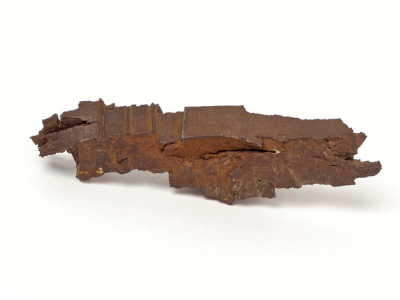
The anti-aircraft batteries ceased fire at 3:40am, and at 4:25am the all-clear was sounded. However, the danger did not pass with the all-clear, as 70 or more unexploded bombs remained littered across the city, either damaged or on time-delayed fuses.
Fire services from southern Ireland were sent north, this time 130 firemen with engines and ambulances. They noted the damage was much greater than the first raid but endured similar dangers with collapsing buildings and time-delayed bombs. They worked to supplement the emergency services in Belfast, returning south around 8:00pm.
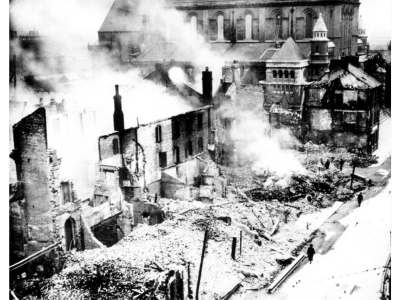
There were fewer casualties, mainly due to the relative accuracy of the attack, the evacuation of much of the population, and better active defences. However, there were still many killed and injured; just over 200 people died during the attack. The tightly-packed working-class areas in the city's east suffered worst during the raid.
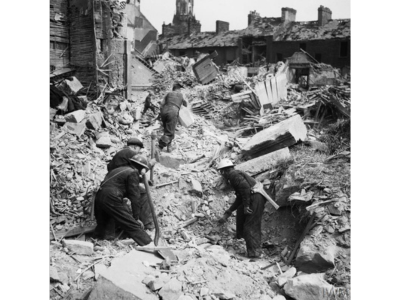
As after the Easter Tuesday raid, unclaimed/unidentified victims were later buried in Milltown and Belfast City cemeteries mass graves on 7 May 1941. Though there were fewer casualties than the Easter Tuesday raid, the raid's impact on the city was profound as basic services failed. Many water mains were broken, and sewage spilt onto the streets. Food was scarce, and shops were closed. The near collapse of public service stirred significant anger in the population, causing a leading senior government official to warn the citizens of Belfast may attack the parliament buildings at Stormont.
The German bombers returned the following night, adding to the people’s misery, but this time in much smaller numbers. Perhaps as few as 3 aircraft attacked the city, with 22 people killed. During this last attack, the RAF fighters scored a rare nighttime victory when a Hurricane of 245 Squadron shot down a Junkers Ju 88 over Ardglass.



